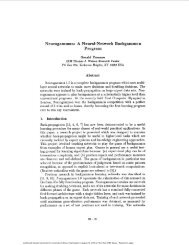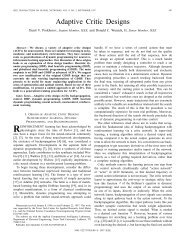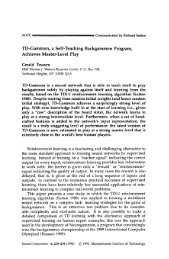Kenji Doya 2001
Kenji Doya 2001
Kenji Doya 2001
- No tags were found...
Create successful ePaper yourself
Turn your PDF publications into a flip-book with our unique Google optimized e-Paper software.
tral paraflocculus during ocular following responses in monkeys. II. Complexspikes,” J. Neurophysiol., vol. 80, pp. 832-848, 1998.[21] S. Kitazawa, T. Kimura, and P.-B. Yin, “Cerebellar complex spikes encodeboth destinations and errors in arm movements,” Nature, vol. 392, pp.494-497, 1998.[22] M. Kawato, K. Furukawa, and R. Suzuki, “A hierarchical neural networkmodel for control and learning of voluntary movement,” Biol. Cybern., vol. 57,pp. 169-185, 1987.[23] M. Kawato, “The feedback-error-learning neural network for supervisedmotor learning,” in Neural Network for Sensory and Motor Systems, R.Eckmiller, Ed. Amsterdam: Elsevier, 1990, pp. 365-372.[24] K. <strong>Doya</strong>, H. Kimura, and A. Miyamura, “Motor control: Neural models andsystem theory,” Appl. Math. Comput. Sci., vol. 11, pp. 101-128, <strong>2001</strong>.[25] A. Miyamura and H. Kimura, “Stability of feedback error learningscheme,” submitted for publication.[26] M. Lotze, P. Montoya, M. Erb, E. Hulsmann, H. Flor, U. Klose, N. Birbaumer,and W. Grodd, “Activation of cortical and cerebellar motor areas during executedand imagined hand movements: An fMRI study,” J. Cognitive Neurosci.,vol. 11, pp. 491-501, 1999.[27] O. Hikosaka, H. Nakahara, M.K. Rand, K. Sakai, X. Lu, K. Nakamura, S.Miyachi, and K. <strong>Doya</strong>, “Parallel neural networks for learning sequential procedures,”Trends Neurosci., vol. 22, pp. 464-471, 1999.[28] J.H. Gao, L.M. Parsons, J.M. Bower, J. Xiong, J. Li, and P.T. Fox, “Cerebellumimplicated in sensory acquisition and discrimination rather than motorcontrol,” Science, vol. 272, pp. 545-547, 1996.[29] S.J. Blakemore, D.M. Wolpert, and C.D. Frith, “Central cancellation ofself-produced tickle sensation,” Nature Neurosci., vol. 1, pp. 635-640, 1998.[30] M. Ito, “Movement and thought: Identical control mechanisms by the cerebellum,”Trends Neurosci., vol. 16, pp. 448-450, 1993.[31] Y.P. Shimansky, “Spinal motor control system incorporates an internalmodel of limb dynamics,” Biol. Cybern., vol. 83, pp. 379-389, 2000.[32] E. Nakano, H. Imamizu, R. Osu, Y. Uno, H. Gomi, T. Yoshioka, and M.Kawato, “Quantitative examinations of internal representations for arm trajectoryplanning: Minimum commanded torque change model,” J.Neurophysiol., vol. 81, pp. 2140-2155, 1999.[33] R.S. Bapi, K. <strong>Doya</strong>, and A.M. Harner, “Evidence for effector independentand dependent representations and their differential time course of acquisitionduring motor sequence learning,” Experimental Brain Res., vol. 132, pp.149-162, 2000.[34] J. Morimoto and K. <strong>Doya</strong>, “Acquisition of stand-up behavior by a real robotusing hierarchical reinforcement learning,” in 17th Int. Conf. MachineLearning, 2000, pp. 623-630.[35] D.M. Wolpert and M. Kawato, “Multiple paired forward and inverse modelsfor motor control,” Neural Net., vol. 11, pp. 1317-1329, 1998.[36] K. <strong>Doya</strong>, K. Samejima, K. Katagiri, and M. Kawato, “Multiple model-basedreinforcement learning,” Japan Sci. and Technol. Corp., Kawato DynamicBrain Project Tech. Rep. KDB-TR-08, 2000.[37] H. Imamizu, S. Miyauchi, T. Tamada, Y. Sasaki, R. Takino, B. Pütz, T.Yoshioka, and M. Kawato, “Human cerebellar activity reflecting an acquiredinternal model of a new tool,” Nature, vol. 403, pp. 192-195, 2000.[38] H. Imamizu, S. Miyauchi, Y. Sasaki, R. Takino, B. Pütz, and M. Kawato,“Separated modules for visuomotor control and learning in the cerebellum: Afunctional MRI study,” in NeuroImage: Third International Conference on FunctionalMapping of the Human Brain, vol. 5, A.W. Toga, R.S.J. Frackowiak, andJ.C. Mazziotta, Eds. Copenhagen, Denmark, 1997, pp. S598.[39] K. Shima, H. Mushiake, N. Saito, and J. Tanji, “Role for cells in thepresupplementary motor area in updating motor plans,” in Proc. Nat. Academyof Sciences, vol. 93, pp. 8694-8698, 1996.<strong>Kenji</strong> <strong>Doya</strong> received the Ph.D. in engineering from the Universityof Tokyo in 1991. He was a Research Associate at theUniversity of Tokyo in 1986, at the University of California,San Diego, in 1991, and at Salk Institute in 1993. He has beena Senior Researcher at ATR International since 1994, and theDirector of Metalearning, Neuromodulation, and EmotionResearch, CREST, at JST, since 1999. He serves as an actioneditor of Neural Networks and Neural Computation and as aboard member of the Japanese Neural Network Society. Hisresearch interests include reinforcement learning, the functionsof the basal ganglia and the cerebellum, and the rolesof neuromodulators in metalearning.Hidenori Kimura received the Ph.D. in engineering fromthe University of Tokyo in 1970. He was appointed a facultymember at Osaka University in 1970, a Professor with theDepartment of Mechanical Engineering for Computer-ControlledMachinery, Osaka University, in 1987, and a Professorin the Department of Mathematical Engineering andInformation Physics, University of Tokyo, in 1995. He hasbeen working on the theory and application of robust controland system identification. He received the IEEE-CSS outstandingpaper award in 1985 and the distinguishedmember award of the IEEE Control Systems Society in 1996.He is an IEEE Fellow.Mitsuo Kawato received the Ph.D. in engineering fromOsaka University in 1981. He became a faculty member atOsaka University in 1981, a Senior Researcher at ATR Auditoryand Visual Processing Research laboratories in 1988, adepartment head at ATR Human Information Processing ResearchLaboratories in 1992, and the leader of the ComputationalNeuroscience Project at Information Sciences Division,ATR International, in <strong>2001</strong>. He has been the project leader ofthe Kawato Dynamic Brain Project, ERATO, JST, since 1996.He received an outstanding research award from the InternationalNeural Network Society in 1992 and an award from theMinistry of Science and Technology in 1993. He serves as aco-editor-in-chief of Neural Networks and a board member ofthe Japanese Neural Network Society. His research interestsinclude the functions of the cerebellum and the roles of internalmodels in motor control and cognitive functions.54 IEEE Control Systems Magazine August <strong>2001</strong>









